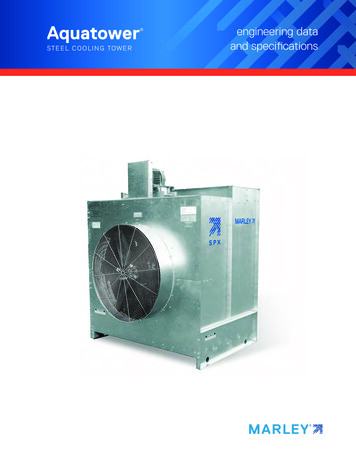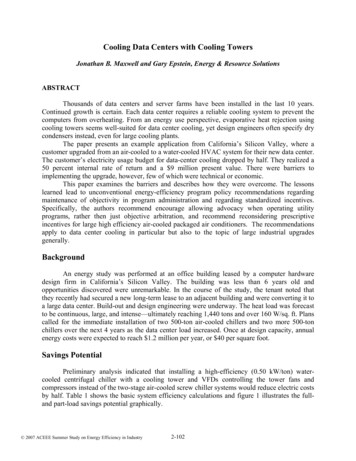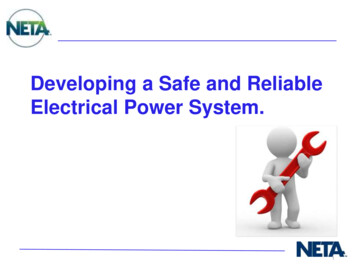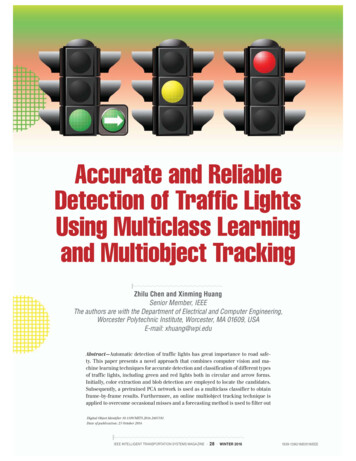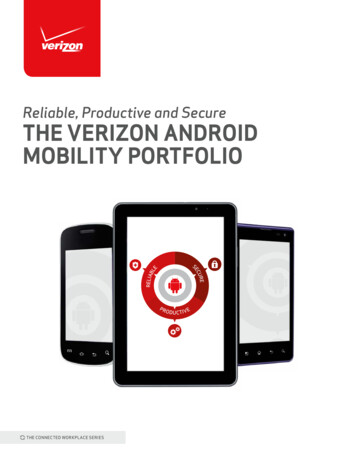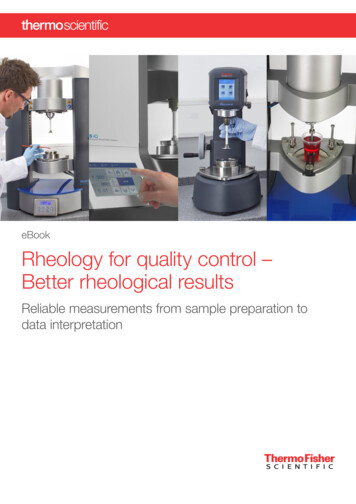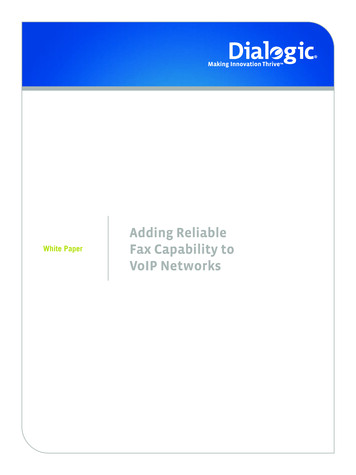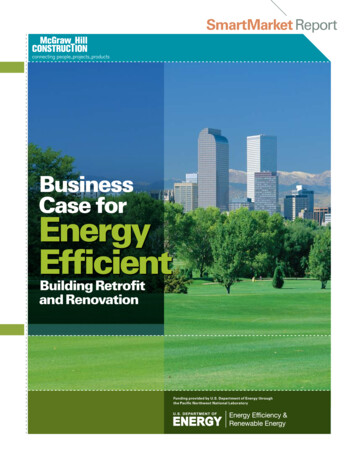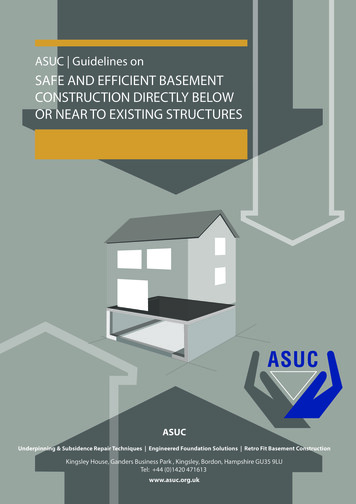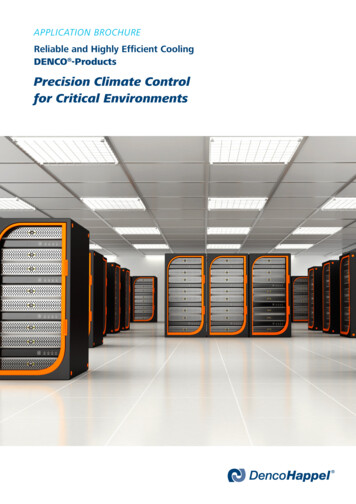
Transcription
Application BrochureReliable and Highly Efficient CoolingDENCO -ProductsPrecision Climate Controlfor Critical Environments
PromiseClose control units are much more than just wordsfor us; they are also a promise. A promise, whichwe can keep due to our long-lasting expertise. Allunits of the Denco product series are bywords forcooling accurate to the degree, exact control ofhumidity and absolutely reliable, space-saving andat the same time energy-efficient air conditioningsolutions.2PR-2014-0004-GB · Subject to modification · R2-09/2015
Our experience shapes your future successEfficient solutionsfor sensitive environmentsWe are involved and experienced in a wide variety of industries: from cooling towersand large volume handlers to office-based comfort cooling. We use this vast pool ofknowledge to supplement our extensive history within the industry to continuallydesign, innovate, redesign and improve our products so we can enable your operationsto thrive.When it comes to close control environments such as data centres, communicationsrooms, laboratories and more, we have the DENCO product portfolio. Our solutionsinclude:Adia-DENCO An air handling unit that utilises the principles of adiabatic cooling to deliverexceptional power to cooling ratio. Decades of experience Comprehensive productportfolio Efficiency focused design System based solutions High quality designs andmanufacture In-house maintenance andservice capabilities Established support network Global presence Trusted and experiencedsuppliersMulti-DENCO An adaptable and reliable solution for efficient cooling that can be applied tomultiple situations and designs.Ultra-DENCO A chilled water underfloor solution with superb cooling and energy performance.Row-DENCO A high density, small footprint unit, which is located amongst or next to servers.Picco-DENCO A smaller, flexible unit, specifically designed for small rooms requiring cooling.Our products are based and driven on efficiency. They are design efficient, serviceefficient, control efficient and most importantly energy efficient. With reports suggesting that energy consumption within data centres accounts for approximately 2 % ofglobal energy use, which is equivalent to the aviation sector, never before has energyefficiency been so fundamental to the future of the industry.We do not only supply you with efficient components, but can supply efficient systemsas well. With a wide range of industry knowledge, we provide ideal solutions to workin harmony with new or existing subsystems, maximising the potential saving returns.Our products are designed and built with the highest quality standards to provide anecological and economical durability to your application. We can provide maintenanceand service capabilities, further extending that durability.We have an established support network and a global presence. With internationallocations of factories, sales offices, service and support, we can be wherever you needus to.PR-2014-0004-GB · Subject to modification · R2-09/20153
We recommend Adia-DENCO Ultra-DENCO Multi-DENCO Row-DENCOData CentresWe consider a large data centre to be greater than 5000 m2 foot print, a medium data centre to beup to 5000 m2 and a small data centre to be up to 500 m2. For all sizes of data centres, higher levelsof investment are available to ensure high energy saving for a quicker payback period. Data centrecustomers will be looking for the best technology available to give maximum efficiency along witha consistent cooling solution. They will want good redundancy features whilst maintaining the abilityto adapt to a fast paced and everchanging industry. They will ultimately be looking for a “24 byforever” solution and will not want their mechanical services to limit their IT potential.Server RoomsWe recommend Adia-DENCO Picco-DENCO Row-DENCOEnterprises or end-user clients who must keep control of their servers and data may maintainsmaller scale data centres or rooms up to a scale of 100 m2 with lower density equipment. Theymay not have space or resources to operate a comprehensive redundancy, but they will wantconsistency of design, simplicity and reliability. Ultimately they will want a system that is efficient,easily configurable and allows them to have a good level of uptime to meet their business needs.4PR-2014-0004-GB · Subject to modification · R2-09/2015
Laboratories, Archive Stores and MuseumsCooling capacity requirements of these types of rooms may not be as high or as dense asdata centres, but the requirements for close control will be equal or higher. For these custom-We recommend Multi-DENCO Picco-DENCOers, energy efficiency is a desired metric, but it comes second to the accuracy and controlwith the customer needs over that climate. The precision required is enabled by the DENCOproduct range by use of both variable cooling and variable heating to enable a precise andcontinuous environmental control. This coupled with humidifier options and dehumidificationusing heater control allows for ideal climate management.Telecom and Switching RoomsThe crossroads for most communications within a building, the telecom rooms, can bea critical point for the network management of an enterprise. Whilst not requiring largeamount of space or particularly large cooling capacities, users will still need the controlWe recommend Multi-DENCO Picco-DENCOand protection of a good environment for the equipment to work in.PR-2014-0004-GB · Subject to modification · R2-09/20155
Cooling is essential, efficiency is the keyOptimise conditionsand maximise your savingsThe Uptime Institute Unbiased, third-party datacentre research organisation Founded in 1993 www.uptimeinstitute.comWith energy costs increasing pressure on data centres and more than two-thirdsdescribing that reducing energy consumption is “very important”1, control of roomtemperature is no longer our industry’s only priority. Buying more efficient equipmentcan be a good start, but you can maximise savings by evaluating your operatingconditions, enabling cost reduction to be made year-on-year.ASHRAEASHRAE Thermal Guidelines2 American Society of Heating,Refrigerating and Air-Conditioning Engineers Mission statement: To advancethe arts and sciences ofheating, ventilation, air-conditioning and refrigeration toserve humanity and promote aClassDry-BulbTemperature ( C)Humidity Range(Non Condensing)A115 – 3220 % to 80 % RHA210 – 35A35 – 40-12 C DP & 8 % to 85 % RHA45 – 45-12 C DP & 8 % to 90 % RHMaximum Rate ofChange ( C/hr)5 / 20Class B and C do not apply to data centres.sustainable world. Founded as ASHAE in 1894 Modern format due to mergerof ASHAE and ASRE in 1959 www.ashrae.orgFor the classes above, the guidelines have a recommended dry bulb temperature rangeof 18 C to 27 C. DENCO products recognise the developments in IT equipment andare designed to capitalise on these capabilities. The higher temperatures allow forbetter efficiency thoughout our range. Alongside this opportunity, we also haveknowledge and experience of other methods to save energy: A sensible heat ratio (SHR) of 1 is best for performance. All the energy used is goingdirectly into cooling the dry-bulb temperature of the air.Any other value than 1 shows that energy is being wasted. EC fans or inverter compressors enable great energy savings. These technologiescombined and networking strategies, such as running redundancy, enable greatersavings than the sum of the individual parts. Use hot and/or cold aisle configuration: higher air inlet temperatures increasefreecooling potential. Humidifiers can be a source of energy waste: a sealed room can reduce or removehumidification needs or only require installation of humidifiers on some units. Air tightness expresses how well sealed the room is. It helps the stability and controlof an environment.1Uptime Institute 2013 Data Centre Industry Survey – Matt Stansberry & Julian KudritzkiAllowable boundaries are expansive values based on assessment of specification and adhering to2 ASHRAE assessment methodology. Values: “2011 Thermal Guidelines for Data Processing Environments– Expanded Data Center Classes and Usage Guidance”6PR-2014-0004-GB · Subject to modification · R2-09/2015
The formulas for economisingIncrease your profitson the bottom lineSHR: Sensible Heat RatioAn SHR of 1 is ideal. It demonstrates that all the energy is being used to cool the air,whereas a lower value shows that the moisture content in the air is being changedduring the cooling process, i.e. condensation is being made. Other methods ofcalculating SHR include looking at inlet or outlet temperatures and moisture.Sensible Heat Radio Gross Sensible CapacityGross Total CapacitySEER: Seasonal Energy Efficiency RatioAs EER values would vary when comparing the same system in different locationswith different climates, the SEER is a useful annualised comparison. The use of totalis to signify a time period relating to interest.Seasonal Energy Efficiency Ratio Total Effective CoolingTotal Power InputEER: Energy Efficiency RatioThe EER expresses a comparison of the how much useful cooling has been maderelative to the amount of power that has been used by the unit. It is a sample of aspecific condition at a particular moment and would be affected by conditions indoorsas well as outside of the building.Energy Efficiency Radio Effective CoolingPower InputPUE: Power Usage EffectivenessThis metric has received rapid adoption by the industry as a simple method to give aratio as to the power requirements to maintain operation of your IT equipment. Thisis discussed in greater depth on the next page.Power Usage Effectiveness Total Power ConsumptionPower Consumption by IT EquipmentPR-2014-0004-GB · Subject to modification · R2-09/20157
Spend all your energy on performanceMinimising use, minimising costsFour categories classifythe accuracy of a PUEmeasurement:PUE Category 0 IT load measured at UPSPower usage effectiveness (PUE) is a ratio to assess how much energy has been usedto service or cool the IT equipment in the data centre relative to the amount of energyused by the IT equipment. It has a simple equation:Power Usage Effectiveness Total Power ConsumptionPower Consumption by IT Equipmentoutput(s) Total data centre powermeasured at the utility meters Peak utilisation/demand ina single snapshot measurementPUE Category 1 IT load measured at UPSoutput(s) Total data centre powermeasured at the utility meters 12 month cumulative readingsThe ideal value is 1, where all energy used within the data centre has only been usedon the IT equipment and therefore no cooling, lighting, uninterrupted power supply(UPS) losses or mechanical services have been required to keep the IT equipmentrunning.The Uptime Institute survey estimates that an average PUE amongst data centres is1.651, but also advises that with companies investing in better energy efficientequipment and adopting industry best practice, this number could be reducedconsiderably. Some companies have been noted to perform exceptionally, achievingPUE scores of 1.10 or less, the implication that for every 1 kW of energy they use onIT equipment, it only requires 0.1 kW of energy to cool, light and maintain the datacentre.PUE Category 2 IT load measured at PDUssupporting IT loads Total data centre powermeasured at the utility meters Peak utilisation/demand inWhen using PUE, caution is required: the figure can easily be manipulated. As the ITequipment’s energy is the denominator of the equation, then if you had two quotes,both with the same mechanical equipment, but one has less efficient IT equipment,the less efficient quote would have a better PUE value, even though, in the real world,it would be the wrong option.a single snapshot measurementWe would recommend, where possible, using the highest category as the measure-PUE Category 3ment technique for sampling your PUE. The lower the category the less accurate your IT load measured at the pointsample of PUE will be. It could be affected by hot or cold days as well as by under-of connection of IT devices toutilised IT equipment. Using a lower category will also mean it is difficult to know ifelectrical systemyou are making effective improvements to your energy saving. Total data centre powermeasured at utility meters 12 month cumulative readings81 Based on self-reported figures in the Uptime Institute 2013 Data Centre Industry Survey– Matt Stansberry & Julian KudritzkiPR-2014-0004-GB · Subject to modification · R2-09/2015
Green thinking, reliable focusLittle affect, little effectGreen ITGreen IT can mean different things to different individuals or organisations. Forinstance: “Green IT is a collection of strategic and tactical initiatives that directlyreduces the carbon footprint of an organisation’s computing operation” is a partof how BCS, The Chartered Institute for IT, outline the subject.Alternatively, Greenpeace equate ‘Green IT Energy Efficiency Renewable Energy’with an emphasis and focus on the source of the energy, rather than just the efficiencyof the consuming device.Others may combine these ideologies, but the objective is the same: reduce andminimise our industry’s impact of the environment that we inhabit. All our productshave efficiency as a central focus, reducing our consumption, and some products canutilise their environment conditions to provide freecooling for your systems.We believe by having a green approach and technical expertise, combined with ourcustomers desires and applications, we can together make our environment a betterplace for all.Tier ClassificationThe Uptime Institute devised a set of tier classifications to be able to consistentlydescribe and compare data centres and their infrastructure in terms of projectedreliability and uptime availability.The standard is designed in a manner so that any site is limited to its weakest subsystem. It helps individuals to understand and assess complex infrastructure whencomparing across sites and can allow for a common comparable aspect on what mightbe vastly differing designs.DENCO products are designed in awareness of this standard and its growing popularityand use within the industry and therefore have several options to help align with yourtier requirements. Whether that is N 1 networking capabilities for seamless maintenance or dual power supply inputs.PR-2014-0004-GB · Subject to modification · R2-09/20159
Adia-DENCO Large volume meets efficient designThe Ambient EnhancerAdia-DENCO utilises your localclimate for energy efficientoperation. Adiabatic cooling,coupled with a large plate heatexchanger empowers longterm, energy efficient customersto achieve exceptional EERvalues. Up to 300 kW in severalcasing sizes using two airflowconfigurations, means that anysite location can capitalise onthe potential of their ambientclimate.Adia-DENCO has evolved from the well-established CAIR range of air handling units,incorporating adiabatic cooling and being tailored to data centres. The adiabaticprocess is not used constantly. Below approximately 30 kJ / kg (e.g. 15 C, 55 % roomhumidity) it can operate on indirect freecooling. Adiabatic cooling (without usingrefrigeration technology) can extend cooling up to an enthalpy of approximately60 kJ / kg (e.g. 28 C, 50 % room humidity).Adia-DENCO stands for indirect freecooling. It does not expose the room to contaminants in ambient air, ensuring a high quality of cleanliness. It can use Eurovent certifiedbag filters, which ensures that air entering the plate heat exchanger (PHE) is clean andof high quality.Double Plate HeatExchanger inside Large surface area Low air pressure drop Epoxy-coated Sealed aluminium plates10These are only a few features available with a Adia-DENCO unit and when coupledwith an advanced, multi-lingual control interface, makes it a fantastic investment.PR-2014-0004-GB · Subject to modification · R2-09/2015
Peak protectionFor climates with wide variability in their temperatures, Adia-DENCO units can beinstalled with a redundant cooler coil as an option. These coils can cover either peakload or redundancy to ensure smooth operation.Casing configuredAdia-DENCO has a variety of casing features available including indoor and outdoorversions and can be installed with dampers, weather guards and a weather roof. Thecasing material can also be tailored to individual needs.Finest filtrationUsing Eurovent certified bag filters, your unit will ensure durability and effectivenessbetween maintenances. Filters meet EN779:2012 and filter classes G4, M5 and F7 areselectable along with special requests for hygienic, explosion-proof and fire-prooffilters.Adiabatic cooling Optimised nozzle configuration Inbuilt redundancy options No degradation using demineralised waterWater savingAdia-DENCO units use reverse osmosis water which allows for the water to be reusedin adiabatic cooling several times. This dramatically reduces flush cycles from every Water saving controls Stainless steel low pressurenozzleshour to typically once a day. This, combined with intelligent control software, allowsfor water use to be minimised.PR-2014-0004-GB · Subject to modification · R2-09/201511
Case studyReduce costs for capital,installation and consumption Exploits the principles of bothThe graph below shows the temperature and humidity profile of London, UK over afreecooling and adiabaticyear on a psychrometrics chart. The two diagonal lines represent approximate pointscoolingwhere Adia-DENCO unit operation changes. The lower line shows a change from Can reduce or eliminate needfor mechanical cooling withinfreecooling to adiabatic cooling with the higher line showing a transition fromadiabatic to mechanical cooling.central Europe Meets all requirements relatingto Green IT Global compatibilityThose boundaries are representative and we have calculated that you can achieve allthose samples using adiabatic and freecooling only, with a supply air temperature of25 C. We have compared this temperature profile with the rest of central Europe andit has shown that mechanical cooling is not required with an Adia-DENCO withincentral Europe. This design means you can have lower capital costs, lower install costsand, most importantly, lower consumption costs for both energy and water.London, UK12PR-2014-0004-GB · Subject to modification · R2-09/2015
Adia-DENCO Airflow configurationsRoof configurationWall configurationIn this configuration, cold ambient air, entering in the top leftIn this configuration, any air that enters the unit is returnedof this image, passes through the plate heat exchanger and exitsto the same side, therefore allowing the unit to be installedthe unit on the top level out of the right hand side. The airalongside your room. Cold ambient air enters in the bottom leftreturning from the room enters from the bottom right of theof the unit and flows upwards through the plate heat exchang-unit and travels in a straight line through the plate heat ex-er. An advantage of this arrangement is that adiabatic coolingchanger to be returned back to the room out of the bottom leftis possible against the flow of air, improving efficiencies. Airof the unit.returning from the room enters in the top right of the unit andis drawn downwards through the plate heat exchanger, allowingfor cross flow against the ambient air.PR-2014-0004-GB · Subject to modification · R2-09/201513
Ultra-DENCO For high efficiency and consistent temperaturesThe Powerful PerformerUltra-DENCO is driven on coolingperformance. Designed specifically for data centres, it candeliver up to 200 kW of chilledwater cooling by utilising downflow air path with large EC fansmounted directly in the floorvoid. This reduces pressure dropsand delivers exceptional performance for the best economies ofscale.Ultra-DENCO is all about performance. It is specifically designed for high efficiency andconsistent temperatures
rooms, laboratories and more, we have the DENCO product portfolio. Our solutions include: Adia-DENCO An air handling unit that utilises the principles of adiabatic cooling to deliver exceptional power to cooling ratio. multi-DENCO An adaptable and reliable solution for efficient coolin

